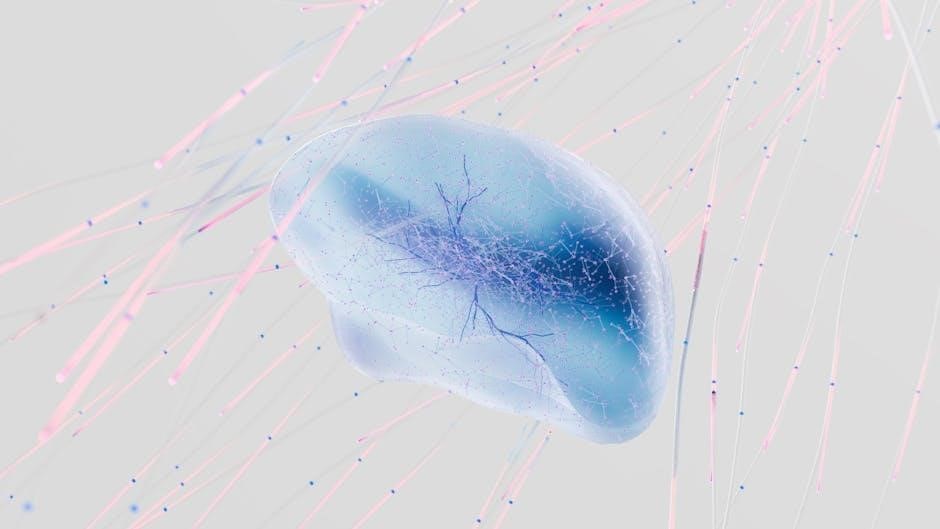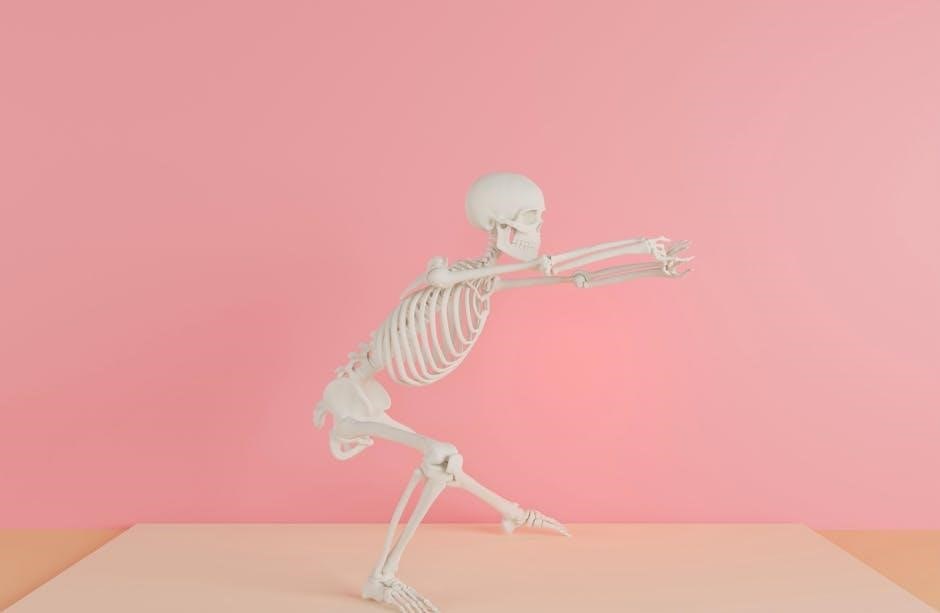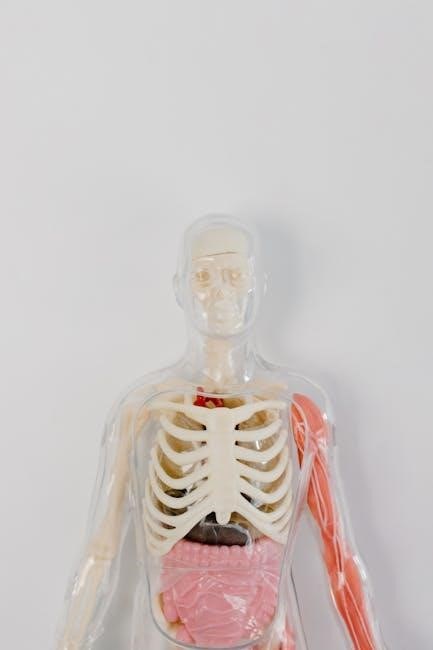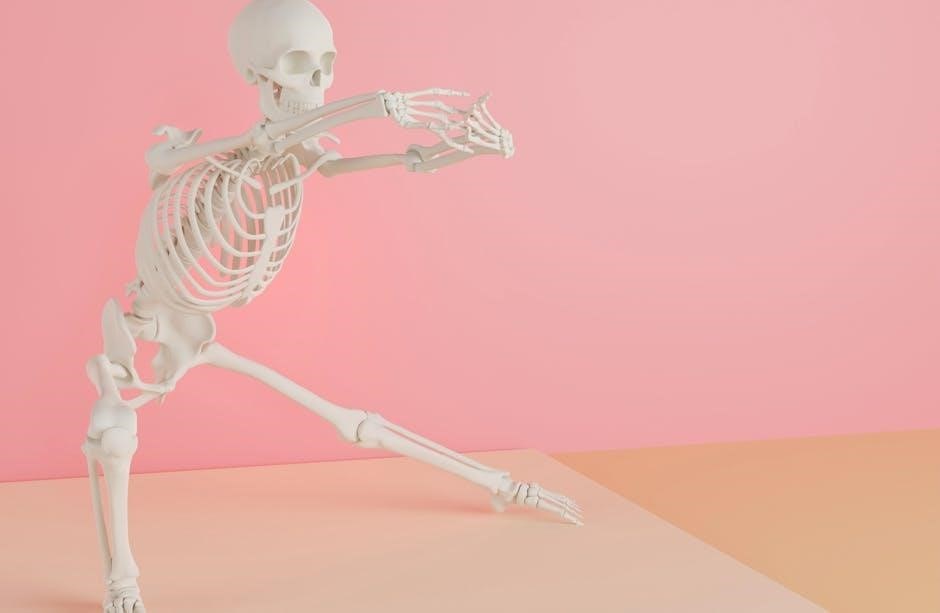skeleton system pdf
Discover the comprehensive guide to the skeleton system. Download your PDF now for detailed insights and illustrations. Perfect for students and professionals!
The skeletal system consists of 206 bones‚ cartilage‚ ligaments‚ and tendons‚ forming the body’s structural framework. It provides support‚ protects organs‚ facilitates movement‚ and produces blood cells‚ essential for overall health and mobility.
Overview of the Skeletal System
The skeletal system is the body’s structural framework‚ comprising 206 bones‚ cartilage‚ ligaments‚ and tendons. It serves as the foundation for movement‚ providing attachment points for muscles and enabling mobility through leverage. This system also protects vital organs‚ such as the brain‚ heart‚ and lungs‚ by enclosing them in bony structures like the skull and ribcage. Additionally‚ the skeletal system stores essential minerals like calcium and phosphorus‚ supporting overall metabolic health. Bones are dynamic tissues that undergo continuous remodeling‚ adapting to physical demands and maintaining strength. The skeletal system is divided into two main parts: the axial skeleton and the appendicular skeleton‚ working together to support the body’s functions and maintain posture.
Importance of the Skeletal System in the Human Body
The skeletal system is vital for maintaining the body’s structure and enabling essential functions. It provides a framework for muscle attachment‚ facilitating movement and maintaining posture. By protecting internal organs‚ such as the brain and heart‚ it ensures their safety from external damage. Additionally‚ the skeletal system plays a crucial role in blood cell production‚ as bone marrow is responsible for creating red and white blood cells. It also serves as a storage site for minerals like calcium and phosphorus‚ which are essential for metabolic processes. Overall‚ the skeletal system is indispensable for supporting life‚ enabling mobility‚ and maintaining overall health and stability.

Structure of the Skeletal System
The skeletal system comprises 206 bones‚ ligaments‚ and tendons‚ organized into axial and appendicular skeletons‚ forming a structural framework essential for body stability‚ movement‚ and protection.
Components of the Skeletal System

The skeletal system includes bones‚ ligaments‚ tendons‚ and cartilage. Bones provide the structural framework‚ while ligaments connect bones to each other‚ and tendons attach muscles to bones. Cartilage acts as padding in joints‚ reducing friction. Together‚ these components work to provide support‚ facilitate movement‚ and protect internal organs. The system is divided into the axial and appendicular skeletons‚ with the axial skeleton including the skull‚ spine‚ and ribcage‚ and the appendicular skeleton comprising the limbs and pelvis. This complex system ensures stability‚ enables mobility‚ and plays a crucial role in overall bodily functions‚ making it an essential part of human anatomy and physiology.
Classification of Bones by Shape
Bones are classified into five categories based on their shapes: long‚ short‚ flat‚ irregular‚ and sesamoid. Long bones‚ such as the femur and humerus‚ have greater length than width and provide leverage for movement. Short bones‚ like those in the wrist and ankle‚ are cube-shaped and provide stability. Flat bones‚ including the skull and ribcage‚ protect internal organs. Irregular bones‚ such as vertebrae and hip bones‚ have unique shapes tailored to specific functions. Sesamoid bones‚ like the patella‚ are embedded in tendons to reduce friction and enhance movement. This classification reflects the diverse roles bones play in the skeletal system.
Differences Between Axial and Appendicular Skeletons
The axial skeleton‚ comprising 80 bones‚ forms the body’s central framework‚ including the skull‚ spine‚ ribs‚ and sternum. It protects vital organs like the brain and viscera. The appendicular skeleton‚ with 126 bones‚ includes the upper and lower limbs‚ shoulders‚ hips‚ and pelvis‚ enabling movement and locomotion. While the axial skeleton focuses on support and protection‚ the appendicular skeleton facilitates mobility and interaction with the environment. Together‚ they form a cohesive system‚ with the axial providing stability and the appendicular allowing flexibility and functional versatility‚ reflecting their distinct yet complementary roles in human anatomy and physiology.

Functions of the Skeletal System
The skeletal system provides structural support‚ protects internal organs‚ facilitates movement through leverage‚ produces blood cells‚ and stores essential minerals like calcium and phosphorus for bodily functions.
Support and Shape to the Body
The skeletal system provides the structural framework of the body‚ giving it shape and stability. Bones act as rigid structures that support the body’s weight and maintain posture. The axial skeleton‚ including the skull‚ spine‚ and ribcage‚ forms the central framework‚ while the appendicular skeleton‚ comprising limbs and girdles‚ allows for movement. Cartilage and ligaments connect bones‚ adding flexibility and cushioning. The skeleton also serves as an attachment point for muscles‚ enabling movement and maintaining body alignment. Without the skeletal system‚ the body would lack its defined form and ability to function effectively‚ making it essential for overall physical structure and stability.
Protection of Internal Organs
The skeletal system plays a vital role in safeguarding the body’s vital organs. The axial skeleton‚ particularly the skull‚ ribcage‚ and vertebrae‚ provides a protective enclosure for sensitive organs. The cranium shields the brain‚ while the ribcage and sternum protect the heart‚ lungs‚ and liver; The vertebral column encases the spinal cord‚ preventing damage. This protective function is crucial for maintaining the integrity of essential organs‚ ensuring they are not easily injured during daily activities or external impacts. The skeletal system’s structural strength and strategic placement of bones create a natural defense mechanism‚ preserving the body’s critical functions and overall health.
Facilitating Movement Through Leverage
The skeletal system facilitates movement by acting as a system of levers‚ enabling muscles to generate force and produce motion. Bones serve as rigid levers‚ while joints act as fulcrums. Muscles attach to bones via tendons‚ pulling on them to create movement. This mechanism allows for various physical actions‚ such as walking‚ running‚ and lifting. The skeletal system provides the structural framework necessary for muscle contraction and movement‚ making it essential for mobility and physical activity. Without this system‚ coordinated movement would not be possible‚ highlighting its critical role in enabling the body to function dynamically and efficiently.
Blood Cell Production and Mineral Storage
The skeletal system plays a vital role in blood cell production and mineral storage. Bones contain bone marrow‚ where hematopoiesis occurs‚ producing red blood cells‚ white blood cells‚ and platelets essential for oxygen transport‚ immunity‚ and blood clotting. Additionally‚ bones act as reservoirs for minerals like calcium and phosphorus‚ which are crucial for bone health and various bodily functions. The bone matrix stores these minerals‚ releasing them into the bloodstream when needed. This dual function highlights the skeletal system’s importance in maintaining both hematological and mineral homeostasis‚ ensuring proper bodily functions and overall health.

Bone Classification and Anatomy
The skeletal system is categorized into types based on shape and function‚ including long‚ short‚ flat‚ irregular‚ and sesamoid bones‚ each with distinct anatomical features.
Types of Bones: Long‚ Short‚ Flat‚ Irregular‚ and Sesamoid
Bones are classified into five types based on their shapes and functions. Long bones‚ such as the femur and humerus‚ are elongated and provide leverage for movement. Short bones‚ like the carpals and tarsals‚ are cube-shaped and provide stability. Flat bones‚ including the skull and sternum‚ protect internal organs. Irregular bones‚ such as vertebrae and hip bones‚ have unique shapes for specific roles. Sesamoid bones‚ like the patella‚ are embedded in tendons to reduce friction. Each type adapts to its anatomical location and functional demands‚ ensuring efficient movement and structural support.
Bone Tissue Composition and Function
Bone tissue is a dynamic‚ specialized connective tissue composed of cells‚ organic matrix‚ and inorganic minerals. The primary cell types include osteoblasts (bone-forming cells)‚ osteocytes (mature bone cells)‚ and osteoclasts (bone-resorbing cells). The organic matrix‚ primarily collagen‚ provides flexibility‚ while minerals like calcium and phosphorus create hardness. Bone tissue is classified into compact (dense outer layer) and cancellous (spongy inner layer)‚ each serving distinct roles. Compact bone provides strength‚ while cancellous bone facilitates mineral storage and blood cell production. This unique composition allows bones to support the body‚ protect organs‚ and adapt to mechanical stresses‚ making bone tissue essential for overall skeletal health and function.

Joints and Their Role in the Skeletal System
Joints are points where bones connect‚ enabling movement‚ providing stability‚ and absorbing shock. They facilitate muscle function and are essential for mobility and structural integrity in the body.
Types of Joints: Fibrous‚ Cartilaginous‚ and Synovial
Joints are classified into three main types based on their structure and function. Fibrous joints‚ held together by dense connective tissue‚ allow little to no movement‚ such as the sutures in the skull. Cartilaginous joints‚ connected by cartilage‚ permit limited movement‚ like the intervertebral discs in the spine. Synovial joints‚ the most common type‚ are characterized by a fluid-filled synovial cavity‚ enabling significant movement‚ such as in the knees and elbows. Each joint type plays a unique role in providing structural support and facilitating various degrees of motion in the body.

Structure and Function of Synovial Joints
Synovial joints are the most common and movable joints in the body. They consist of a synovial cavity filled with synovial fluid‚ which reduces friction and provides nutrients to the cartilage. The joint is enclosed by a fibrous capsule‚ and the ends of the bones are covered with articular cartilage‚ allowing smooth movement. Ligaments strengthen the joint‚ while the synovial membrane produces the lubricating fluid. These joints enable a wide range of motions‚ such as flexion‚ extension‚ rotation‚ and circumduction‚ making them essential for activities like walking‚ running‚ and gripping objects. Their structure and function are vital for maintaining mobility and performing daily tasks efficiently.

Skeletal System Growth and Development
The skeletal system begins developing in the embryonic stage‚ with bones forming through ossification processes. Growth peaks during puberty‚ influenced by hormones and nutrition‚ ensuring proper bone density and structure for lifelong health.
Bone Formation and Ossification Processes
Bone formation begins in the embryonic stage through ossification‚ a process where soft tissue transforms into bone. There are two main types: intramembranous and endochondral ossification. Intramembranous ossification involves bones forming directly from mesenchymal cells‚ while endochondral ossification uses cartilage templates. Osteoblasts deposit bone matrix‚ and osteoclasts remodel it. This process starts in the womb and continues through puberty‚ shaping the skeleton. Proper nutrition and hormones‚ like growth hormone‚ are crucial for healthy bone development. Any disruptions can lead to skeletal abnormalities. Understanding ossification is key to grasping how the skeletal system grows and maintains itself throughout life.
Factors Influencing Skeletal Growth and Health
Nutrition‚ hormones‚ and physical activity significantly influence skeletal growth and health. Adequate calcium and vitamin D intake are crucial for bone mineralization. Growth hormone and sex hormones regulate bone development during puberty. Physical activity‚ especially weight-bearing exercises‚ strengthens bones and enhances density‚ reducing the risk of osteoporosis. Genetics also play a role in determining bone structure and density. Poor diet‚ lack of sunlight‚ and sedentary lifestyles can impair skeletal health‚ leading to conditions like rickets or osteoporosis. Maintaining a balanced lifestyle and monitoring these factors are essential for optimal skeletal development and long-term health.

Common Skeletal System Disorders and Injuries
Common skeletal disorders include fractures‚ arthritis‚ and osteoporosis. Fractures involve bone breaks‚ while arthritis and osteoporosis affect joints and bone density‚ leading to pain and mobility issues.

Fractures: Types and Treatment
Fractures are breaks in bones‚ classified as transverse (across the bone)‚ oblique (diagonal)‚ or comminuted (bone fragments). Treatments include casts‚ braces‚ or surgery to realign and stabilize bones. Physical therapy follows to restore mobility and strength‚ ensuring proper healing and preventing complications. Early diagnosis is crucial for effective recovery‚ as untreated fractures can lead to deformities or chronic pain. Modern medicine offers advanced techniques‚ such as internal fixation with plates or rods‚ for complex cases. Understanding fracture types and treatments is essential for managing skeletal injuries effectively.
Arthritis and Other Degenerative Conditions
Arthritis is a common degenerative condition affecting joints‚ causing pain‚ inflammation‚ and limited mobility. Osteoarthritis‚ the most prevalent type‚ results from cartilage breakdown‚ while rheumatoid arthritis is an autoimmune disorder leading to joint deformities. Other conditions include osteoporosis‚ which weakens bones‚ increasing fracture risk. Treatments vary‚ from lifestyle changes and medications to surgery. Early diagnosis and management are crucial to improve quality of life and slow progression. These conditions highlight the importance of maintaining skeletal health through diet‚ exercise‚ and regular check-ups to prevent or manage degenerative diseases effectively.
The skeletal system is vital for body support‚ movement‚ and organ protection. For deeper understanding‚ explore study guides‚ PDF resources‚ and interactive 3D anatomy models available online.
The skeletal system‚ comprising 206 bones‚ cartilage‚ ligaments‚ and tendons‚ plays a crucial role in body support‚ movement‚ and organ protection. It facilitates blood cell production and mineral storage. The system is divided into the axial and appendicular skeletons‚ with bones classified into long‚ short‚ flat‚ irregular‚ and sesamoid types; Joints enable movement through leverage‚ while cartilage and synovial fluid reduce friction. Understanding the skeletal system’s structure and functions is essential for appreciating its importance in maintaining posture‚ enabling mobility‚ and safeguarding internal organs. Study guides and 3D models are valuable resources for comprehensive learning.
Recommended Study Guides and PDF Resources
Several study guides and PDF resources are available to aid in understanding the skeletal system. A comprehensive guide titled Bones of the Human Skeleton provides detailed diagrams and labels for all 206 bones. Another resource‚ Anatomy of Joints‚ focuses on synovial‚ cartilaginous‚ and fibrous joints‚ offering clear explanations. Additionally‚ The Skeletal System Study Guide includes Latin and Greek roots‚ quizzes‚ and 3D models to enhance learning. These resources are ideal for students‚ educators‚ and enthusiasts seeking in-depth knowledge. They cover bone classification‚ ossification processes‚ and common disorders‚ making them invaluable tools for comprehensive study.

